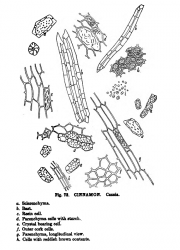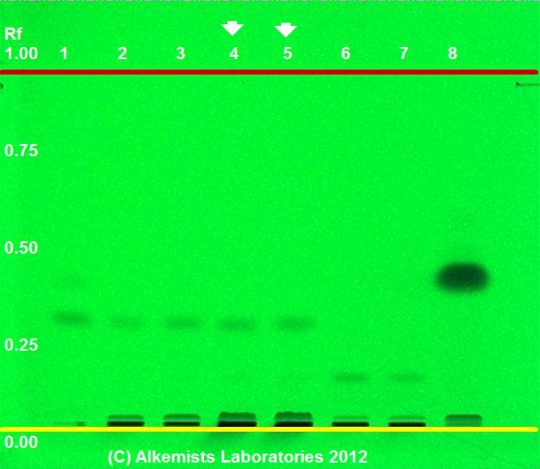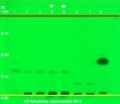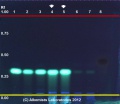Cinnamomum aromaticum (bark)
m |
|||
| Line 3: | Line 3: | ||
''Introduction from Wikipedia, the free encyclopedia (http://en.wikipedia.org/wiki/Cinnamomum_aromaticum, retrieved 02/22/2012).'' | ''Introduction from Wikipedia, the free encyclopedia (http://en.wikipedia.org/wiki/Cinnamomum_aromaticum, retrieved 02/22/2012).'' | ||
| − | ''Cinnamomum aromaticum'', called cassia or Chinese cinnamon, is an evergreen tree native to southern China, Bangladesh, Uganda, India, and Vietnam. Like its close relative ''Cinnamomum verum'', also known as | + | ''Cinnamomum aromaticum'', called cassia or Chinese cinnamon, is an evergreen tree native to southern China, Bangladesh, Uganda, India, and Vietnam. Like its close relative ''Cinnamomum verum'', also known as Ceylon cinnamon, it is used primarily for its aromatic bark, which is used as a spice. In the United States of America, cassia is often sold under the culinary name of "cinnamon". The buds are also used as a spice, especially in India, and were once used by the ancient Romans. |
The tree grows to 10–15 m tall, with greyish bark and hard elongated leaves that are 10–15 cm long and have a decidedly reddish colour when young. | The tree grows to 10–15 m tall, with greyish bark and hard elongated leaves that are 10–15 cm long and have a decidedly reddish colour when young. | ||
| Line 13: | Line 13: | ||
{{Microscopy | source=Schneider, A. (1921) The Microanalysis of Powdered Vegetable Drugs, 2nd ed. | {{Microscopy | source=Schneider, A. (1921) The Microanalysis of Powdered Vegetable Drugs, 2nd ed. | ||
| mainimage=Microanalysis_powdered_vegetable_google_ver_cinnamon_cassia.png | | mainimage=Microanalysis_powdered_vegetable_google_ver_cinnamon_cassia.png | ||
| − | | description= | + | | description=Cassia (powdered bark) (''Cinnamomum aromaticum'') [Lauraceae] (''Cinnamomum Cassia'' auct.) |
| color=Cinnamon brown (reddish brown). | | color=Cinnamon brown (reddish brown). | ||
| flavor=Sweet, pungent, somewhat astringent. | | flavor=Sweet, pungent, somewhat astringent. | ||
| Line 19: | Line 19: | ||
| characteristics=Rather short, thick walled bast cells sclerenchyma with cell walls unequally thickened parenchyma cells with compound starch granules; cells with numerous small prismatic crystals; large resin bearing cells; cells of outer bark suberized and with reddish brown contents. Cassia bark contains relatively more starch than do the other varieties of cinnamon barks and relatively less bast tissue. | | characteristics=Rather short, thick walled bast cells sclerenchyma with cell walls unequally thickened parenchyma cells with compound starch granules; cells with numerous small prismatic crystals; large resin bearing cells; cells of outer bark suberized and with reddish brown contents. Cassia bark contains relatively more starch than do the other varieties of cinnamon barks and relatively less bast tissue. | ||
| ash=Ash about 6.5 per cent. | | ash=Ash about 6.5 per cent. | ||
| − | | adulterants=Cassia cinnamon in particular is likely to be adulterated with inferior cassia barks, clove bark, flour, inert vegetable substances. The quality of cassia cinnamon is proportionate to the number of bast cells present. The very inferior grades show few bast cells, which indicates that the outer older bark tissue predominates. Cassia | + | | adulterants=Cassia cinnamon in particular is likely to be adulterated with inferior cassia barks, clove bark, flour, inert vegetable substances. The quality of cassia cinnamon is proportionate to the number of bast cells present. The very inferior grades show few bast cells, which indicates that the outer older bark tissue predominates. Cassia could readily be graded according to the bast cell count. The organoleptic tests, especially taste and odor, are also valuable guides to quality. |
| }} | | }} | ||
| + | |||
=HPTLC Entries= | =HPTLC Entries= | ||
| − | {{HPTLC | source= | + | {{HPTLC | source=Elan M. Sudberg, Alkemist Laboratories |
| − | | description= | + | | description=Cassia (bark) (''Cinnamomum aromaticum'' Nees) |
| companyimage=AP-LOGO-Laboratories Crop - Copy.jpg | | companyimage=AP-LOGO-Laboratories Crop - Copy.jpg | ||
| companyURL=http://www.alkemist.com | | companyURL=http://www.alkemist.com | ||
| mainimage=Cinnamon-2.jpg | | mainimage=Cinnamon-2.jpg | ||
| − | | caption1=Cinnamomum aromaticum HPTLC UV 254 nm | + | | caption1=''Cinnamomum aromaticum'' HPTLC UV 254 nm |
| image2=Cinnamon-3.jpg | | image2=Cinnamon-3.jpg | ||
| − | | caption2=Cinnamomum aromaticum HPTLC 10% Ethanolic KOH Reagent 365 nm | + | | caption2=''Cinnamomum aromaticum'' HPTLC 10% Ethanolic KOH Reagent 365 nm |
| stationaryphase=Silica gel 60, F254, 10 x 10 cm HPTLC plates | | stationaryphase=Silica gel 60, F254, 10 x 10 cm HPTLC plates | ||
| mobilephase=toluene: ethyl acetate [9.5/0.5] | | mobilephase=toluene: ethyl acetate [9.5/0.5] | ||
| prep=0.3g+3mL CH3OH sonicate/heat @~50° C ~ 1/2 hr. | | prep=0.3g+3mL CH3OH sonicate/heat @~50° C ~ 1/2 hr. | ||
| detection=Image 1 UV 254 nm; Image 2 10% Ethanolic KOH Reagent 365 nm | | detection=Image 1 UV 254 nm; Image 2 10% Ethanolic KOH Reagent 365 nm | ||
| − | | lanes=Lane 2(3μl) | + | | lanes=Lane 2(3μl) ''Cinnamomum aromaticum'' / ''Cinnamomum cassia'' (bark); Lane |
| − | 3(3μl) | + | 3(3μl) ''Cinnamomum aromaticum'' / ''Cinnamomum cassia'' (bark); Lane 6(3μl) ''Cinnamomum verum'' (bark); Lane 7(3μl) ''Cinnamomum |
| − | + | verum'' (bark) authenticated by macroscopic, microscopic &/or TLC studies according to the reference source cited below, held at Alkemists Pharmaceuticals, Costa Mesa, CA. | |
| − | verum (bark) authenticated by macroscopic, microscopic &/or TLC studies according to | + | | reference=Method Developed by Alkemists Laboratories |
| − | the reference source cited below, held at Alkemists Pharmaceuticals, Costa Mesa, CA. | + | |
| }} | | }} | ||
Revision as of 21:43, 16 October 2012
Contents |
Introduction
Introduction from Wikipedia, the free encyclopedia (http://en.wikipedia.org/wiki/Cinnamomum_aromaticum, retrieved 02/22/2012).
Cinnamomum aromaticum, called cassia or Chinese cinnamon, is an evergreen tree native to southern China, Bangladesh, Uganda, India, and Vietnam. Like its close relative Cinnamomum verum, also known as Ceylon cinnamon, it is used primarily for its aromatic bark, which is used as a spice. In the United States of America, cassia is often sold under the culinary name of "cinnamon". The buds are also used as a spice, especially in India, and were once used by the ancient Romans.
The tree grows to 10–15 m tall, with greyish bark and hard elongated leaves that are 10–15 cm long and have a decidedly reddish colour when young.
The quoted text in this section was licensed for use under the Creative Commons ShareAlike License, version 3.0: http://creativecommons.org/licenses/by-sa/3.0/
Macroscopic Entries
Microscopic Entries
|
HPTLC Entries
|
Cassia (bark) (Cinnamomum aromaticum Nees) Lane Assignments Lane 2(3μl) Cinnamomum aromaticum / Cinnamomum cassia (bark); Lane 3(3μl) Cinnamomum aromaticum / Cinnamomum cassia (bark); Lane 6(3μl) Cinnamomum verum (bark); Lane 7(3μl) Cinnamomum verum (bark) authenticated by macroscopic, microscopic &/or TLC studies according to the reference source cited below, held at Alkemists Pharmaceuticals, Costa Mesa, CA. Stationary Phase Silica gel 60, F254, 10 x 10 cm HPTLC plates Mobile Phase toluene: ethyl acetate [9.5/0.5] Sample Preparation Method 0.3g+3mL CH3OH sonicate/heat @~50° C ~ 1/2 hr. Detection Method Image 1 UV 254 nm; Image 2 10% Ethanolic KOH Reagent 365 nm Reference see Method Developed by Alkemists Laboratories Source: Elan M. Sudberg, Alkemist Laboratories [2] |
Other Points of Interest
Cite error: <ref> tags exist, but no <references/> tag was found




